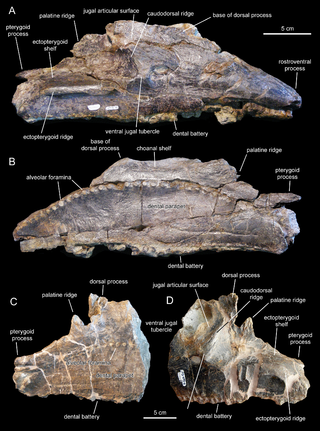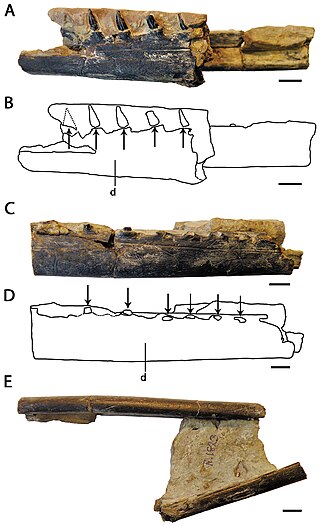
Lorisidae is a family of strepsirrhine primates. The lorisids are all slim arboreal animals and comprise the lorises, pottos and angwantibos. Lorisids live in tropical, central Africa as well as in south and southeast Asia.
The forearm is the region of the upper limb between the elbow and the wrist. The term forearm is used in anatomy to distinguish it from the arm, a word which is used to describe the entire appendage of the upper limb, but which in anatomy, technically, means only the region of the upper arm, whereas the lower "arm" is called the forearm. It is homologous to the region of the leg that lies between the knee and the ankle joints, the crus.

In human anatomy, the subclavian arteries are paired major arteries of the upper thorax, below the clavicle. They receive blood from the aortic arch. The left subclavian artery supplies blood to the left arm and the right subclavian artery supplies blood to the right arm, with some branches supplying the head and thorax. On the left side of the body, the subclavian comes directly off the aortic arch, while on the right side it arises from the relatively short brachiocephalic artery when it bifurcates into the subclavian and the right common carotid artery.
The Chiroteuthidae are a family of deep-sea squid, generally small to medium in size, rather soft and gelatinous, and slow moving. They are found in most temperate and tropical oceans, but are known primarily from the North Atlantic, North Pacific, and Indo-Pacific. The family is represented by approximately 12 species and four subspecies in four genera, two of which are monotypic. They are sometimes known collectively as whip-lash squid, but this common name is also applied to the Mastigoteuthidae, which are sometimes treated as a subfamily (Mastigoteuthinae) of Chiroteuthidae.

Oegopsida is one of the two orders of squid in the superorder Decapodiformes, in the class Cephalopoda. Together with the Myopsina, it was formerly considered to be a suborder of the order Teuthida, in which case it was known as Oegopsina. This reclassification is due to Oegopsina and Myopsina not being demonstrated to form a clade.

A brachial plexus injury (BPI), also known as brachial plexus lesion, is an injury to the brachial plexus, the network of nerves that conducts signals from the spinal cord to the shoulder, arm and hand. These nerves originate in the fifth, sixth, seventh and eighth cervical (C5–C8), and first thoracic (T1) spinal nerves, and innervate the muscles and skin of the chest, shoulder, arm and hand.

Pararhabdodon is a genus of tsintaosaurin hadrosaurid dinosaur, from the Maastrichtian-age Upper Cretaceous Tremp Group of Spain. The first remains were discovered from the Sant Romà d’Abella fossil locality and assigned to the genus Rhabdodon, and later named as the distinct species Pararhabdodon isonensis in 1993. Known material includes assorted postcranial remains, mostly vertebrae, as well as maxillae from the skull. Specimens from other sites, including remains from France, a maxilla previously considered the distinct taxon Koutalisaurus kohlerorum, an additional maxilla from another locality, the material assigned to the genera Blasisaurus and Arenysaurus, and the extensive Basturs Poble bonebed have been considered at different times to belong to the species, but all of these assignments have more recently been questioned. It was one of the last non-avian dinosaurs known from the fossil record that went extinct during the Cretaceous-Paleogene extinction event.

The taxonomic order Rhynchonellida is one of the two main groups of living articulate brachiopods, the other being the order Terebratulida. They are recognized by their strongly ribbed wedge-shaped or nut-like shells, and the very short hinge line.

Mnesarchaeoidea is a superfamily of "New Zealand primitive moths" containing one family, Mnesarchaeidae, and a two genera, Mnesarchaea and Mnesarchella, both of which are endemic to New Zealand.

The white-tailed mole is a species of mammal in the family Talpidae. It is found in Bangladesh, China, India, and Myanmar. This species are endemic to East Asia and exhibit limited distributions. It is the only species in the genus Parascaptor.

Atrypa is a genus of brachiopod with round to short egg-shaped shells covered with many fine radial ridges. Growth lines form perpendicular to the costae and are spaced approximately 2 to 3 times further apart than the costae.. The pedunculate valve is slightly convex, but oftentimes levels out or becomes slightly concave toward the anterior margin. The brachial valve is highly convex. Neither valve contains an interarea. Atrypa had a large geographic range and occurred from the late Lower Silurian (Telychian) to the early Upper Devonian (Frasnian). Other sources expand the range from the Late Ordovician to Carboniferous, approximately from 449 to 336 Ma. A proposed new species, A. harrisi, was found in the trilobite-rich Floresta Formation in Boyacá, Colombia.
Arizonerpeton is an extinct genus of nectridean tetrapodomorphs. It contains a single species, Arizonerpeton wellsi. It lived in what is now the Swisshelm Mountains of modern-day Arizona, United States. This locality belongs to the Black Prince Limestone Formation, which is dated to the middle Pennsylvanian sub-period of the Carboniferous period.

Athyris is a brachiopod genus with a subequally biconvex shell that is generally wider than long and a range that extends from the Silurian into the Triassic. Athyris is the type genus for the Athyrididae, which belongs to the articulate order Athyridida. R.C. Moore (1952) gives a shorter range, from the Mid Devonian to the Lower Mississippian.

Cyrtospirifer is an extinct genus of brachiopods. The fossils are present in the Middle and Upper Devonian.

Fukuivenator is an extinct genus of maniraptoran theropod dinosaur from the Early Cretaceous of Japan.

Serradraco is a genus of Early Cretaceous pterodactyloid pterosaur from the Valanginian aged Tunbridge Wells Sand Formation in England. Named by Rigal et al. in 2018 with the description of a second specimen, it contains a single species, S. sagittirostris, which was formerly considered a species of Lonchodectes, L. sagittirostris. In 2020, Averianov suggested it did not belong in Lonchodectidae.
Rhombopholis is an extinct genus of archosauromorph reptile known from England. The type species of Rhombopholis is Rhombopholis scutulata. Specimens of this genus were collected from the Leamington quarry, near Warwick. This locality belongs to the Bromsgrove Sandstone Formation, which is dated to the Anisian age of the Middle Triassic, approximately 245 million years ago.
Jaffaia is a monotypic genus of brachiopods belonging to the family Dallinidae. The only species is Jaffaia jaffaensis from southern Australia. The species was described by Blochmann in 1910 and recently re-described in the Australian Journal of Taxonomy.
Ammitocyon is a genus of large sized carnivoran mammals, belonging to the Amphicyonidae, that lived during the Late Miocene in what is now Spain. It is notable for its extreme adaptations towards hypercarnivory, its extremely robust skeleton, and was one of the last surviving members of its family.












